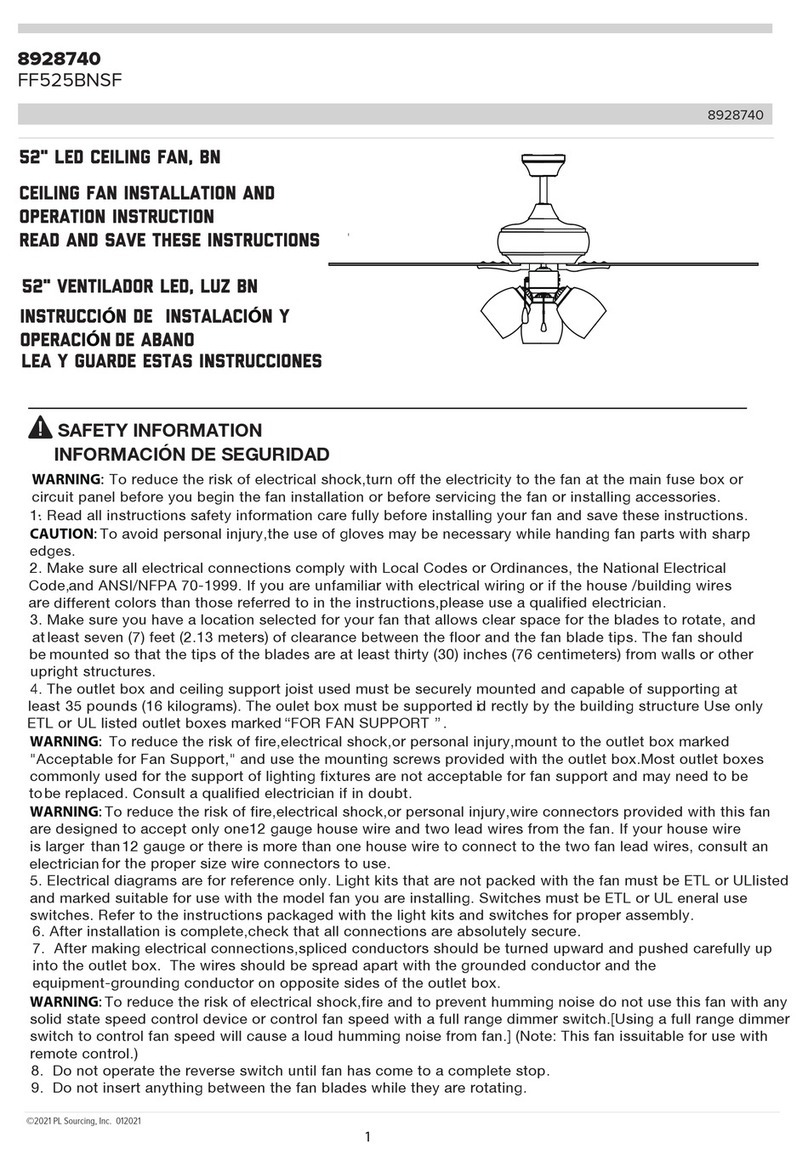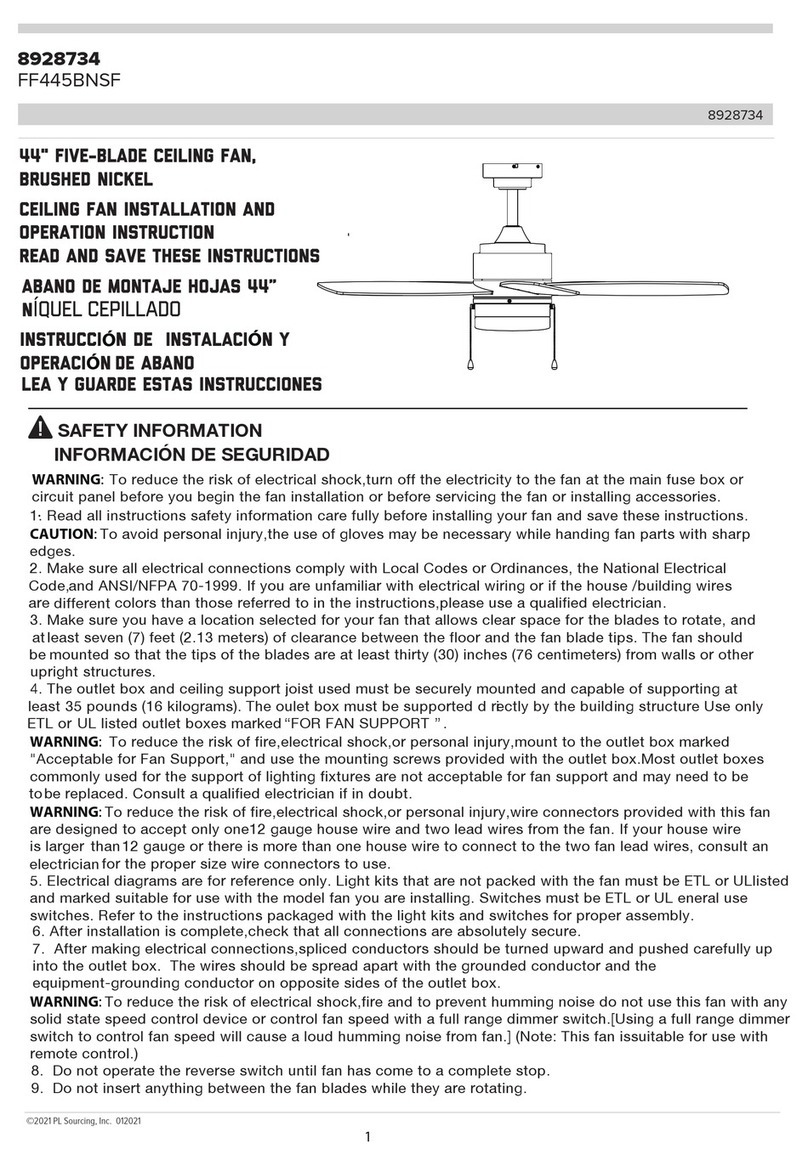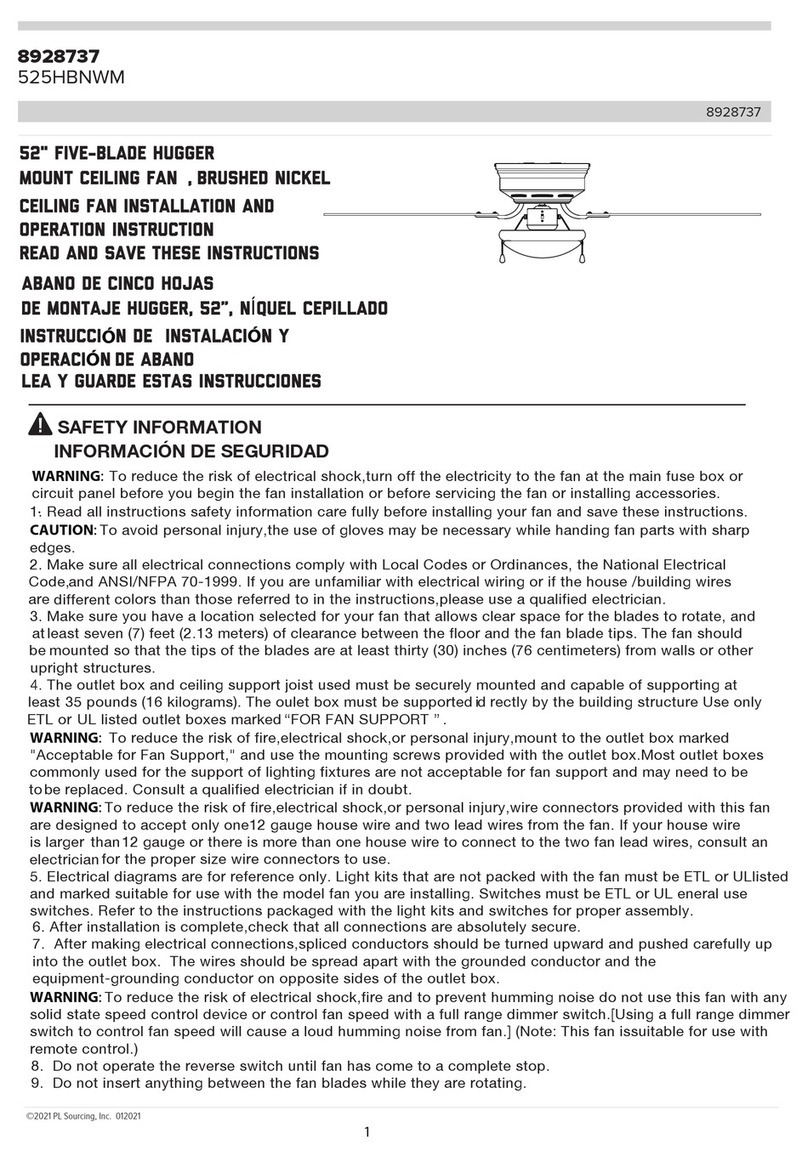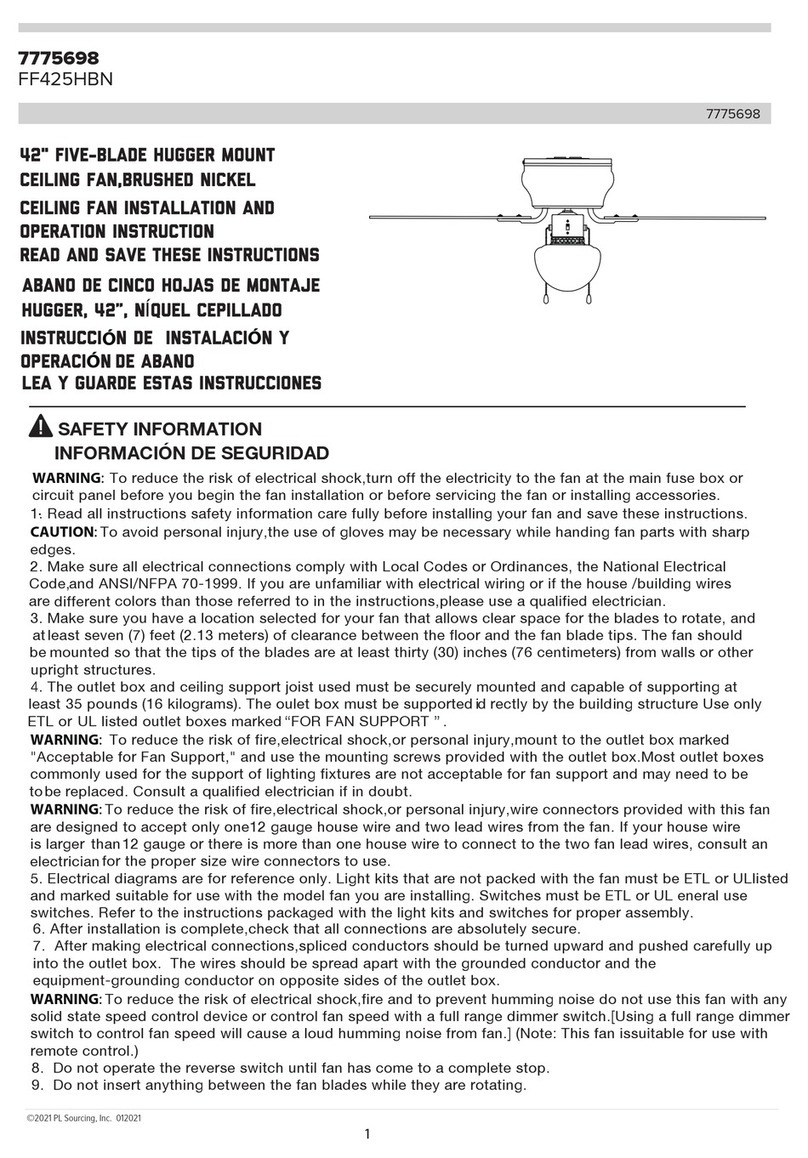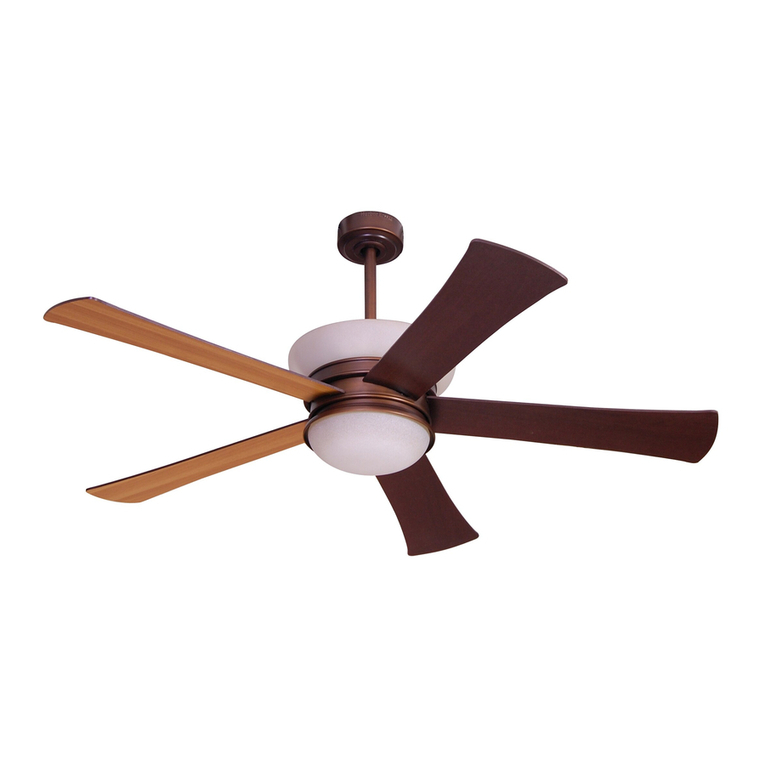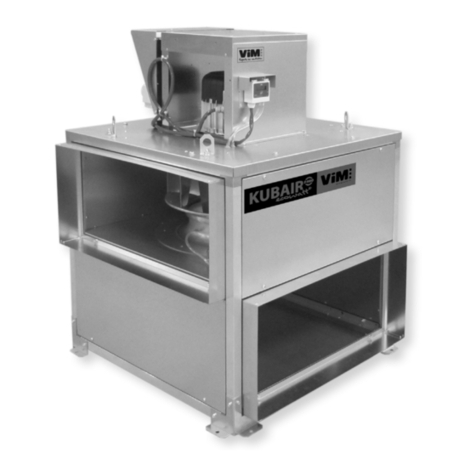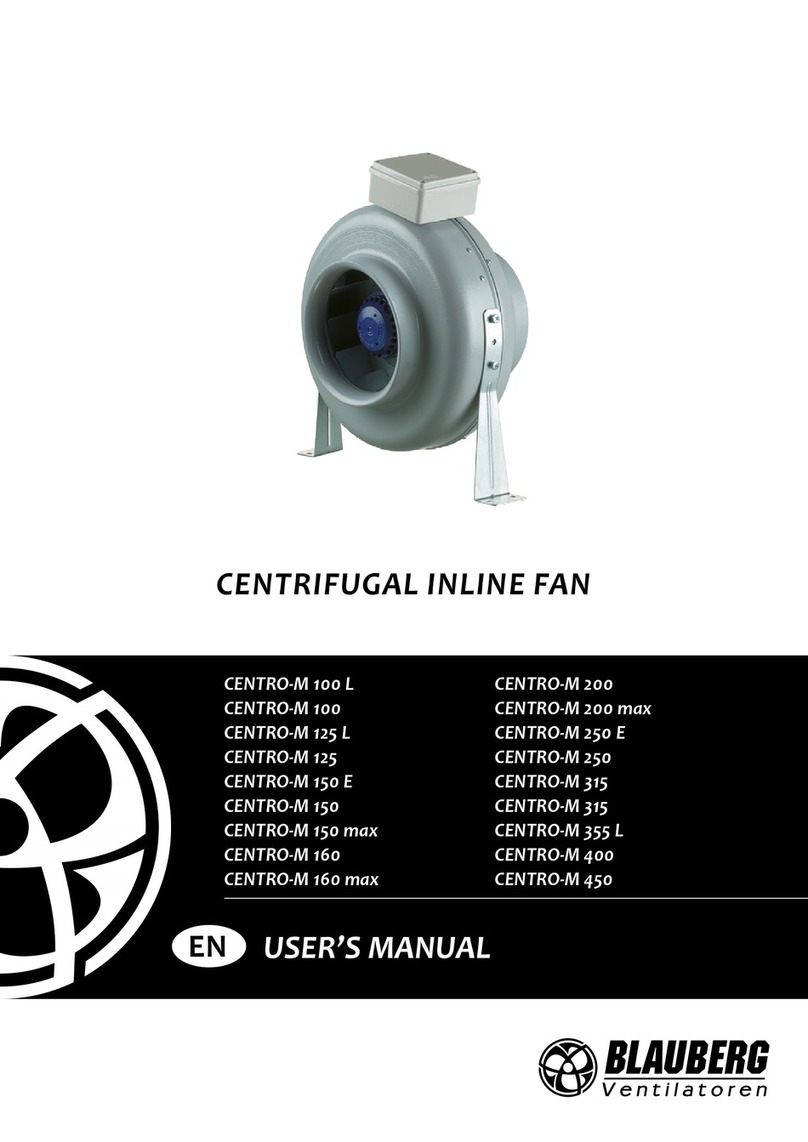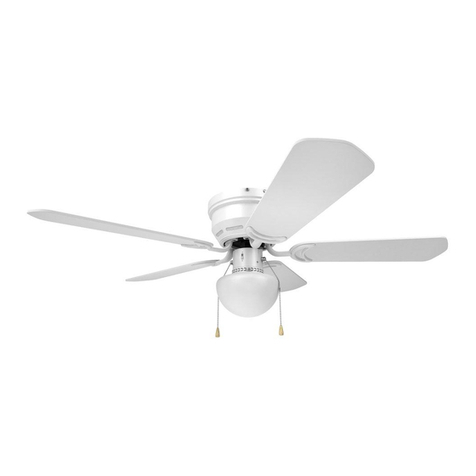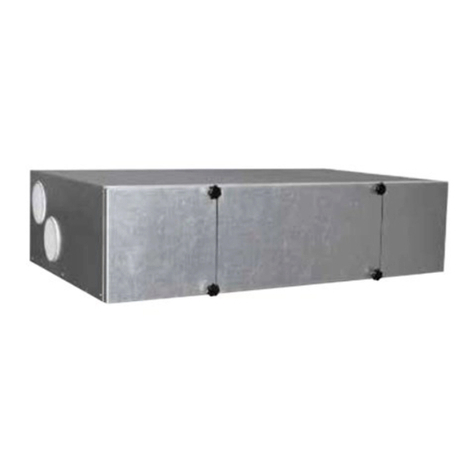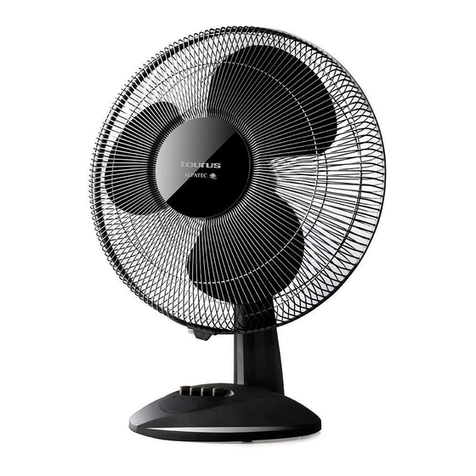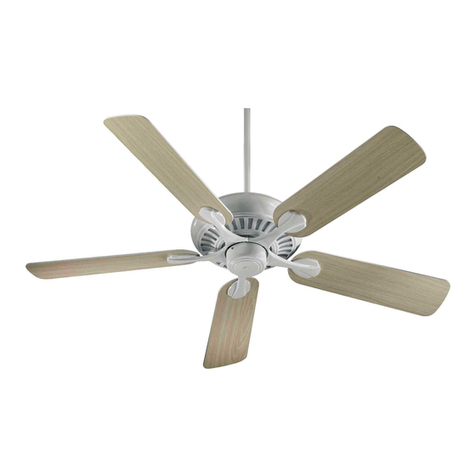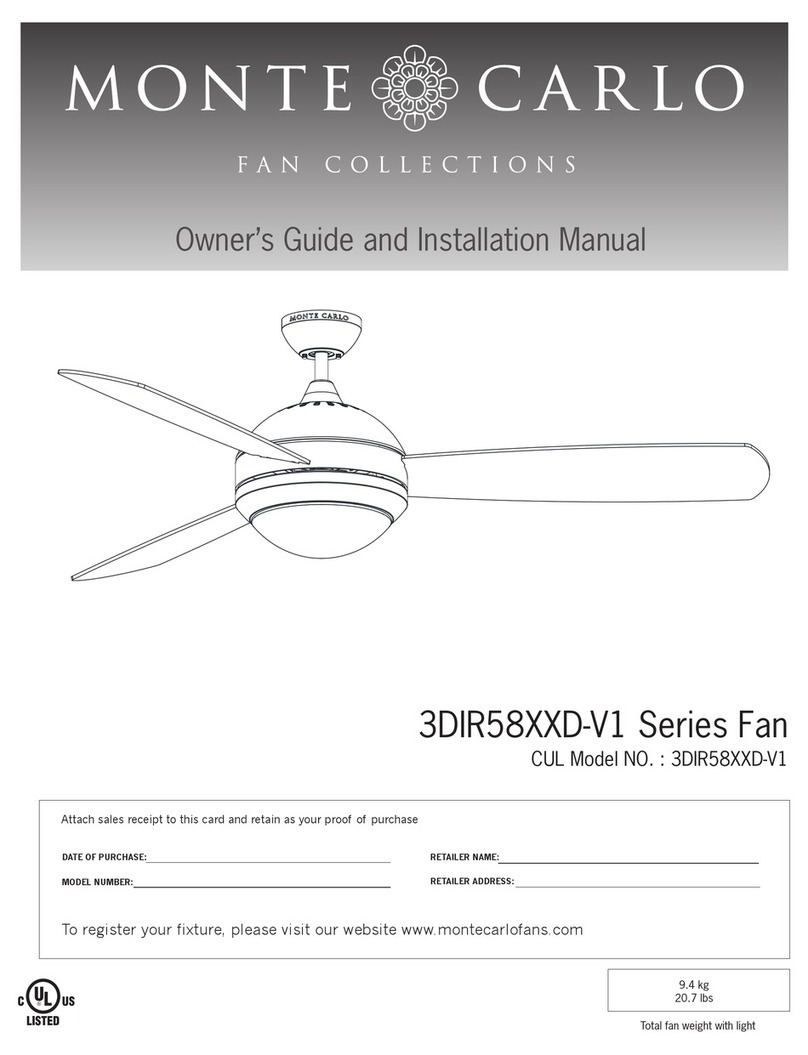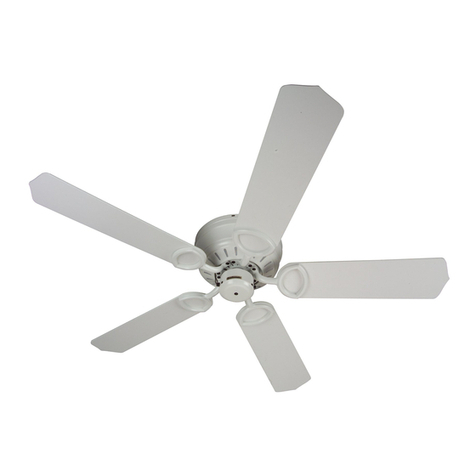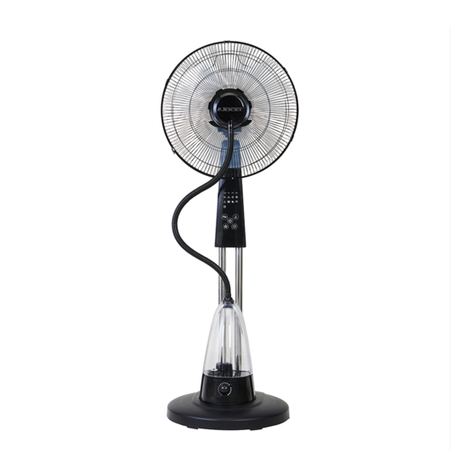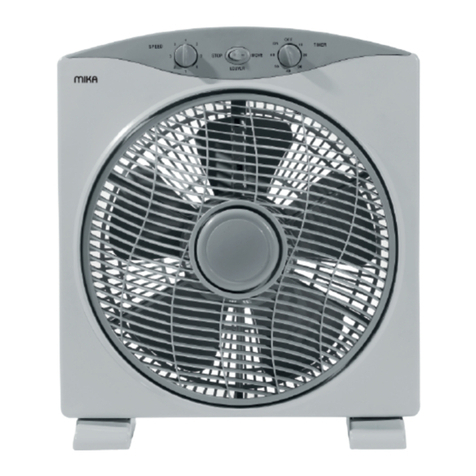
Important Safety Instructions
WARNING: 3N@UNHCkQDRGNBJ@MCRDQHNTRODQRNM@KHMITQXENKKNVSGDRDHMRSQTBSHNMR
1 1D@C XNTQ NVMDQR L@MT@K @MC RaEDSX HMENQm@SHNM ADENQD iMRS@KKHMF XNTQ MDV E@M 1DUiDV SGD @BBNLO@MXHMF @RRDLAKX
CH@FQ@LR
2 !DENQD RDQUHBHMF NQ BKD@MHMF TMHS RVHSBG ONVDQ NEE @S RDQUHBD O@MDK @MC KNBJ RDQUHBD O@MDK CHRBNMMDBSHMF LD@MR SN OQDUDMS
ONVDQ EQNL ADHMF RVHSBGDC NM @BBHCDMS@KKX 6GDM SGD RDQUHBD CHRBNMMDBSHMF LD@MR B@MMNS AD KNBJDC RDBTQDKX E@RSDM a
V@QMHMFCDUHBDRTBG@R@S@FSNSGDRDQUHBDO@MDK
3!DB@QDETK NE SGD E@M @MC AK@CDR VGDM BKD@MHMF O@HMSHMF NQ VNQJHMF MD@Q SGD E@M KV@XR STQM NEE SGD ONVDQ SN SGD BDHKHMF
E@MADENQDRDQUHBHMF
4 #NMNSHMRDQS@MXSGHMFHMSNSGDE@MAK@CDRVGHKDSGDE@MHRNODQ@SHMF
A d di t io n a l Sa fe t y In s t ruc t i o ns
1To avoid ONRRHAKD RGNBJ bDRTQD DKDBSQiBiSX iRSTQMDd oEE @S SGD ETRD box ADENQD VHQHMF @MC do MNS NODQ@SD E@M VHSGNTS
AK@CDR
2 KK VHQHMF @MC HMRS@KK@SHNM OQNBDCTQDR LTRS R@SHREX -@SHNM@K $KDBSQHB@K "NCDR (ANSI/ NFPA 70-1999) @MC +NB@K "NCDR 3GD
BDHKHMF E@M LTRS AD FQNTMCDC @R a OQDB@TSHNM @F@HMRS ONRRHAKD DKDBSQHB@K RGNBJ $KDBSQHB@K HMRS@KK@SHNM RGNTKC AD L@CD NQ
@OOQNUDCAX@KHBDMRDCDKDBSQHBH@M
3 3GD EaMb@RD mTRS bDRDBTQDKX mNTMSDd aMC B@OaAKD NE QDKiaAKX RTOONQSHMF @S KD@RS 35 KAR E@M aMC @BBDRRoQiDR MNS So
DWBDDC KAR NQ JFR 2DD O@FD 5 NE NVMDQR L@MT@K ENQ RTOONQS QDPTHQDLDMSR "NMRTKS a PT@KHkDC DKDBSQHBH@M HE HM
CNTAS
4 3GDE@MLTRSADLNTMSDCVHSGSGDE@MAK@CDR@SKD@RSEDDSEQNLSGDlNNQSNOQDUDMS@BBHCDMS@KBNMS@BSVHSGSGDE@MAK@CDR
5 %NKKNV SGD QDBoLLDMCDd HMRSQTBSHNMR EoQSGD OQNODQ LDSGNC oEVHQHMF XoTQ BDiKHMF E@M IEXNT do MNS G@UD adDPT@SD
DKDBSQHB@KJMNVKDCFDNQDWODQHDMBDG@UDXNTQE@MHMRS@KKDCAXKHBDMRDCDKDBSQHBH@M
6 2THS@AKDENQTRDVHSGRNKHCRS@SDRODDCBNMSQNKR
WARNING :3GHR OQ
WARNING: 3.1$#4"$3'$1(2*.%2'."*3'(2% -,423!$(-23 ++$#6(3' &$-$1 +42$(2.+ 3(-&6 ++
".-31.+26(3"'
NCTBS iRdDRHFMDd SN TRD oMKX SGNRD O@QSR RTOOKHDd VHSG SGHR OQNCTBS @MCNQ aBBDRRNQHDR CDRHFM@SDd
RODBHkB@KKX ENQ TRD VHSG SGHR OQNCTBS 4RHMF O@QSR @MCNQ @BBDRRNQHDR MNS CDRHFM@SDC ENQ TRD VHSG SGHR OQNCTBS BNTKC QDRTKS HM
ODQRNM@KHMITQXNQOQNODQSXC@L@FD
WARNING :To QDCTBD SGD QHRJ NE ODQRNM@K HMITQX do MNS ADMC SGD AK@CD AQ@BJDS l@MFD NQ AK@CD GNKCDQ VGDM HMRS@KKHMF SGD
AQ@BJDSRA@K@MBHMFSGDAK@CDRNQBKD@MHMFSGDE@M#NMNSHMRDQSENQDHFMNAIDBSRHMADSVDDMQNS@SHMFE@MAK@CDR
LIMITED LIFETIME WARRANTY
Extends to the original purchaser of a Miseno Fan
1 +(,(3$# +(%$3(,$ ,.3.1 WARRANTY - (E @MX O@QS NE XNTQ E@M LNSNQ E@HKR CTD SN a CDEDBS HM L@SDQH@KR NQ VNQJL@MRGHO
CTQHMF SGD KHEDSHLD NE SGD NQHFHM@K OTQBG@RDQ ,HRDMN VHKK OQNUHCD SGD QDOK@BDLDMS O@QS EQDD NE BG@QFD VGDM SGD CDEDBSHUD
E@M HR QDSTQMDC SN NTQ M@SHNM@K RDQUHBD BDMSDQ /QNNE NE OTQBG@RD HR QDPTHQDC "TRSNLDQ RG@KK AD QDRONMRHAKD ENQ @KK BNRSR
HMBTQQDCHMSGDQDLNU@KNQQDHMRS@KK@SHNM@MCRGHOOHMFNESGDOQNCTBSENQQDO@HQRNQQDOK@BDLDMS
2ONE YEAR ,.3.1 LABOR WARRANTY - (E XNTQ E@M LNSNQ E@HKR @S @MX SHLD VHSGHM NMD XD@Q EQNL SGD NQHFHM@K OTQBG@RD CTD
SN CDEDBSR HM L@SDQH@KR NQ VNQJL@MRGHO K@ANQ SN QDO@HQ SGD moSNQ VHKK AD OQNUHCDC EQDD NE BG@QFD @S NTQ M@SHNM@K RDQUHBD
BDMSDQ /TQBG@RDQ VHKK AD QDRONMRHAKD ENQ K@ANQ BG@QFDR @ESDQ SGiRNMDXD@Q ODQHNC "TRSNLDQ RG@KK AD QDRONMRHAKD ENQ @KK
BNRSRHMBTQQDCHMSGDQDLNU@KNQQDHMRS@KK@SHNM@MCRGHOOHMFNESGDOQNCTBSENQQDO@HQRNQQDOK@BDLDMS
3(E @MX NSGDQ OaQS oEXNTQ E@M EaHKR @S @MX SHLD VHSGHM oMD XD@Q aESDQ oQHFHMaKOTQBG@RD dTD SN a CDEDBS HM L@SDQH@KR oQ
VNQJL@MRGHO VD VHKK QDO@HQ NQ QDOK@BD @S NTQ NOSHNM SGD CDEDBSHUD O@QS EQDD NE BG@QFD ENQ O@QSR @MC K@ANQ ODQENQLDC @S NTQ
M@SHNM@KRDQUHBDBDMSDQ
4BDB@TRD NE vaQXHMF BKHL@SD BNMCHSHNMR SGHR VaQQ@MSX CNDR MNS BNUDQ BG@MFDR HM SGD kMHRG HMBKTCHMF QTRSHMF OHSSHMF
BNQQNCHMFS@QMHRGHMFNQODDKHMF
5 3GHR V@QQ@MSX iRvoid aMC doDR MNS aOOKX So damaFD EQom imOQNODQ HMRSaKKaSHNM MDFKDBS @BBidDMS miRTRD DWONRTQD So
DWSQDLDRNEGD@SNQGTLHCHSXNQ@R@QDRTKSNE@MXLNCHkB@SHNMSNSGDNQHFHM@KOQNCTBS
6 KK BNRSR NE QDLNU@K @MC QDHMRS@KK@SHNM NE SGD E@M @QD SGD RNKD QDRONMRHAHKHSX NE SGD NVMDQ NE SGD E@M @MC MNS SGD RSNQD SG@S
RNKCSGDE@MNQ,HRDMN
7 ,HRDMN QDRDQUDR SGD QHFGS So LNCHEX NQ CHRBNMSHMTD @MX OQNCTBS @S @MX SHLD @MC L@X RTARSHSTSD @MX OaQS TMCDQ SGHR
V@QQ@MSX
5 3GD@OOKH@MBDHRMNSHMSDMCDCENQTRDAXXNTMFBGHKCQDMNQHMkQLODQRNMRVHSGNTSRTODQUHRHNM8NTMFBGHKCQDMRGNTKCAD
RTODQUHRDCSNDMRTQDSG@SSGDXCNMNSOK@XVHSGSGD@OOKH@MBD
3GHRE@MHRSNADTRDCHMCQXKNB@SHNMNMKX
#NMNSNODQ@SDQDUDQRHMFRVHSBGTMSHKE@MAK@CDRG@UDBNLDSN@BNLOKDSDRSNO
%NQRTOOKXBNMMDBSHNMRHESGDBNMCTBSNQNE@E@MHRHCDMSHkDC@R@FQNTMCDCBNMCTBSNQSGDMHSRGNTKCADBNMMDBSDCSN@
FQNTMCDCBNMCTBSNQONVDQRTOOKX(ESGDBNMCTBSNQNE@E@MHRHCDMSHkDC@R@MTMFQNTMCDCBNMCTBSNQSGDMHSRGNTKCAD
BNMMDBSDCSN@MTMFQNTMCDCBNMCTBSNQONVDQRTOOKX(ESGDBNMCTBSNQNE@E@MHRHCDMSHkDCENQDPTHOLDMSFQNTMCHMFSGDMHS
RGNTKCADBNMMDBSDCSN@MDPTHOLDMSFQNTMCHMFBNMCTBSNQ
9ISiRTMCDQRSood SG@S aMX QDOaiQoQQDOK@BDLDMS HR SGD DWBKTRHUD QDLDCX @U@HKaAKD EQNL ,HRDMN 3GDQD HR MN NSGDQ
DWOQDRRDC NQ HLOKHDC V@QQ@MSX ,HRDMN GDQDAX CHRBK@HLR @MX @MC @KK HLOKHDC V@QQ@MSHDR HMBKTCHMF ATS MNS KHLHSDC SN
SGNRD NE mDQBG@MS@AHKHSX @MC kSMDRR ENQ a O@QSHBTK@Q OTQONRD SN SGD DxSDMS ODQmiSSDd bXKaV SoLD RSaSDR do MNS aKKNV
KHLHS@SHNMR NM HLOKHDC V@QQ@MSHDR ,HRDMN VHKK MNS AD KH@AKD ENQ HMBHCDMS@K BNMRDPTDMSH@K NQ RODBH@K C@L@FDR @QHRHMF NTS
NE NQ iMBNMITMBSHNM VHSG OQNCTBS TRD NQ ODQENQL@MBD DWBDOS @R L@X NSGDQVHRD AD @BBNQCDC AX K@V 3GHR V@QQ@MSX FHUDR XNT
RODBH@KKDF@KQHFGSR@MCXNTL@X@KRNG@UDNSGDQQHFGSRSG@SU@QXEQNLRS@SDSNRS@SD
10 BDQS@HM@LNTMSNEVNAAKDHRMNQL@K@MCRGNTKCMNSADBNMRHCDQDC@OQNAKDLNQ@CDEDBS
4MCDQ MN BHQBTLRS@MBDR L@X a E@M AD QDSTQMDC VHSGNTS OQHNQ @TSGNQHY@SHNM EQNL ,HRDMN 3GD QDBDHOS NE OTQBG@RD LTRS
@BBNLO@MX @TSGNQHYDC QDSTQMR @MC LTRS AD RDMS EQDHFGS OQDO@HC SN ,HRDMN 3GD E@M SN AD QDSTQMDC LTRS AD OQNODQKX
O@BJDCSN@UNHCC@L@FDHMSQ@MRHS,HRDMNVHKKMNSADQDRONMRHAKDENQ@MXC@L@FDQDRTKSHMFEQNLHLOQNODQO@BJ@FHMF
